
The gold price has recovered after falling to a one-month low due to a drop in the US dollar. Additionally, the expectation that the Federal Reserve will cut interest rates is growing. Additionally, a shift in investor sentiment has been a key driver of the recovery. It is brought on by indicators of geopolitical instability and deteriorating U.S. economic data. As a result, markets get ready for more hints about the state of the economy and monetary policy.
How Dollar Drop Supports Gold Price Rebound
The gold price opened higher during early European hours on Monday. Friday’s weak U.S. personal spending and income data added pressure on the U.S. dollar. Consequently, it is increasing the appeal of gold, which is valued in dollars.
Generally speaking, gold draws more foreign investors when the value of the US dollar drops. Furthermore, global events have an impact on the shift in sentiment. The U.S.-China trade agreement and the Iran-Israel ceasefire were two examples of events that reduced market uncertainty.
Economic Data Points to Possible Rate Cut
According to the US Bureau of Economic Analysis, there was a 0.1% decline in personal spending in May. For the first time since 2021, personal income dropped by 0.4 percent. These figures suggest that consumer resilience is eroding, which would motivate the Fed to reduce interest rates.
Meanwhile, the Fed’s preferred inflation indicator, the PCE Price Index, grew 2.3% annually, as anticipated. Moreover, core inflation, which does not include food and energy, rose to 2.7%. These stable inflation numbers support a dovish policy approach even more.
Austan Goolsbee of Chicago and Raphael Bostic of Atlanta, two Fed officials, will be speaking at least on Monday. Their comments could have a significant impact on the trend for a rate cut and the market. While gold traders remain cautious, the direction of policy could have a significant impact on near-term price trends.
Bullish Signs Hold as Gold Maintains Uptrend
While gold’s (XAU/USD) price had previously firmed up and retraced in price, it remains bullish over the long term. It also remains above the critical 100-day Exponential Moving Average (EMA) level. There is certainly the possibility of some near-term weakness as the 14-day Relative Strength Index is below 50; however, gold is bullish.
The near-term resistance is roughly a $3,350 high from June 26; if gold gets through $3,350, it may eventually test $3,400 or may even test $3,425. On the downside, $3,170 and $3,120 are support levels, showing that this trade is hinging on the next data point.
Overall, the view around gold is cautiously optimistic. A weaker US dollar, dovish Fed signalling, and a more stable inflation environment are all things that our tangents are moving positively. Future upside potential may be constricted if we have potentially better international relations and less demand for safe-haven assets.
Bottom Line
As geopolitical tensions and unexpected economic data come to a close, the Fed is once again in the spotlight. As a result, the next few weeks will be critical because of the reports that will set the tone for the rate reduction timeline. A dovish Fed policy and a weak US dollar are necessary for this. To predict the next move in gold, investors should keep an eye on central bank statements and changes in risk sentiment.







